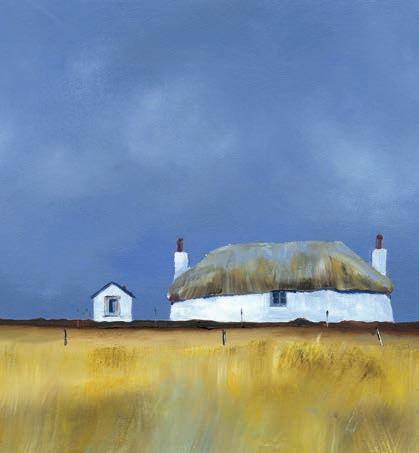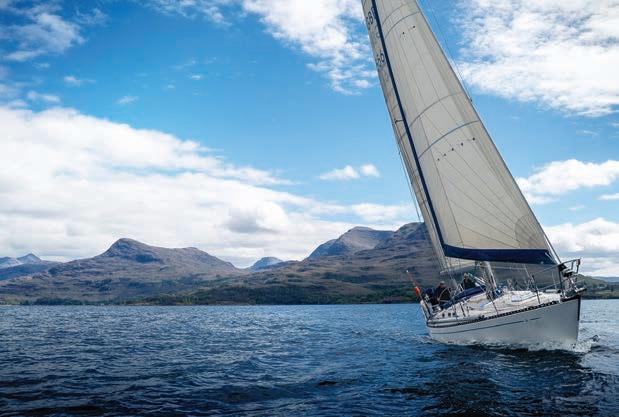
4 minute read
Arts & Culture
FRINGE PRODUCTIONS

Across the islands of the west coast, art and culture are on the move. From the Aros Community Theatre in Portree, through the Uist’s Taigh Chearsabhagh Museum & Arts Centre – which partners with the University of the Highlands and Islands to offer courses in fine art to degree level – to the multiple venues of Mull’s Comar, arts organisations manage to both cultivate local creativity and attract tours from around the country. Alongside the buildings that maintain a constant stream of events and exhibitions, local spaces such as Arran’s Whiting Bay Hall or Minginish Community Hall on Skye can be pressed into service, ensuring that there is a year-round provision of performance, while museums frequently rotate exhibitions to include contemporary visual art alongside more traditional work.
This means that not only do the islands receive their share of touring productions – or in the case of Comar, events made on the island by Mull Theatre – and visual art exhibitions, but that the organisations promoting the arts are engaged in sophisticated and inclusive community-orientated curation. On Skye, ATLAS Arts is developing an ongoing series of community meals that combine food activism, film, public discussions and a grand night out under the name of Plural Futures. With a commitment to encouraging makers to produce durational and temporary work that ‘creates connections between artists and audiences and responds to the unique qualities of the region’, ATLAS combines a contemporary aesthetic sensibility with a recognition of Skye’s distinctive identity.
Across on Arran, Arran Visual Arts’ Summer Exhibition (23–29 May) allows members to show and sell their work, while May sees Ruth Bond’s oil paintings of the outer Hebrides arrive at Talla na Mara on the Isle of Harris. Like ATLAS’ programme, these events engage with the environment and culture of the islands: since the beauty of the landscape attracts artists, it is unsurprising that communities can generate their own exhibitions.
Comar, based in Mull and incorporating multiple forms of art – the organisation evolved from the merger of Mull Theatre and the artist space An Tobar – hosts exhibitions and touring theatre. Three shows, all of which have garnered awards and praise on earlier tours of the UK and at the Edinburgh Fringe Festival, are arriving in Comar in the upcoming months.
Like Animals comes from Glasgow’s Superfan, known for its blend of theatre and live art. With deeply personal touches taken from the real-life relationship between the two
FRINGE PRODUCTIONS
Up and down the western fringe of Scotland, Gareth K Vile finds a range of venues and multi-art spaces offering compelling visual art, performance and cinema in the course of 2020
performers, Like Animals considers communication through the perspectives discovered in the study of animal languages. Superfan’s bold dramaturgy draws on circus and dance, setting it in the rare position of being both experimental and accessible.
Waves, which follows the fictional biography of the woman who invented the butterfly stroke, is both performed and written by Alice Mary Cooper. Telling the story of a woman born on Australia’s Gabo island, it began as a short story but evolved into a celebration of ‘the pioneering women swimmers of the early 1900s’. Although the main character is Cooper’s invention, the show opens up a rarely discussed period of swimming history and speaks of those who developed the sport but remain unacknowledged, or even mentioned, in the textbooks. Waves concludes its Scottish tour on the Isle of Mull. 2Magpies’ Ventoux arrives in Skye at the beginning of May and, interestingly, revisits another sporting event – the 2000 Tour De France – in which the champion, later to be disgraced, cyclists Lance Armstrong and Marco Pantini went head-to-head. Restaging the race, with video footage, commentary and two actors on bicycles, 2Magpies’ reinterprets what was, at the time, a contest of respected athletes but has become, in retrospect, a meeting of tarnished heroes. With adventurous staging – the actors and video footage work together with a soundtrack that includes Kraftwerk’s famous ‘soundtrack’ of the Tour – Ventoux is a creative response to the sport itself and a subtle analysis of cultural values.
Perhaps the most ambitious project around the islands, however, comes from the National Theatre of Scotland. Supported by Caledonian MacBrayne, with community projects accompanying the shows in Stornoway, Rothesay and Craignure, FerryTales is a new script from Isobel MacArthur – most recently praised for her adaptation of Pride andPrejudice – with Perth Theatre’s Lu Kemp directing. Told in English, Gaelic and BSL (British Sign Language), and with music from Josie Duncan, Ferry Tales reflects on the routes to the isles, the people who make the journeys and the unique sense of time and place that happens along the way.
Far from being disconnected from the mainland’s cultural production, the islands have plenty of visits from national companies, but at the same time, have generated a distinctive approach to how art and theatre can be appreciated, while using them both to speak of their locality, communities and culture.

From top left, clockwise: Alice in Wasteland screening, as part of Plural Futures; Like Animals; Ventoux; Croft Yellow Grasses by Ruth Bond


















